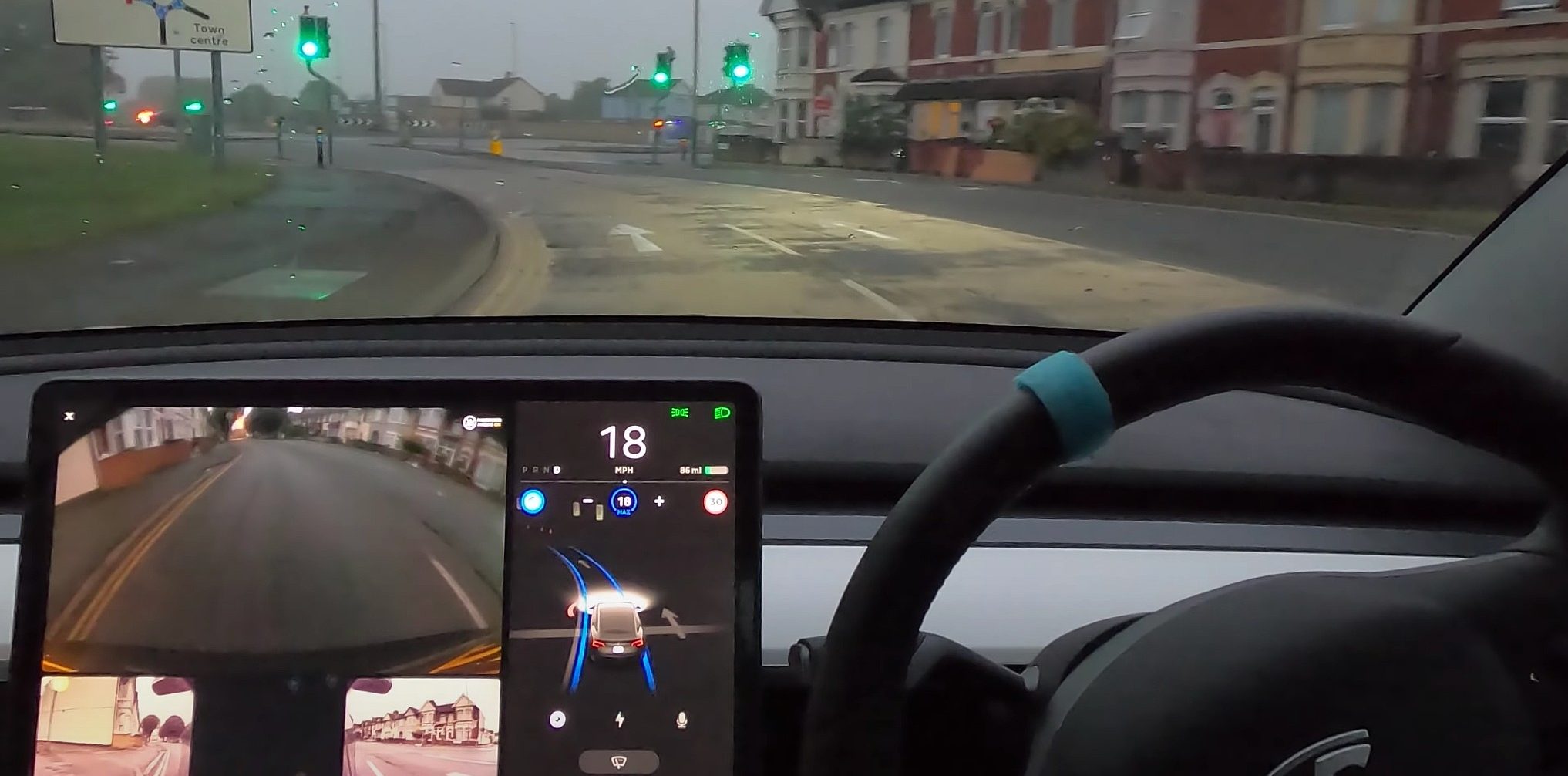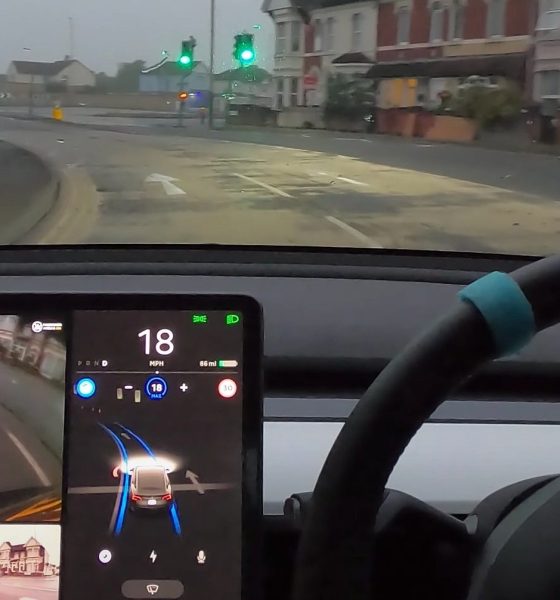

News
Tesla’s FSD Beta is navigating through roundabouts with great confidence
Ever since Tesla rolled out its Full Self-Driving Beta last week, the lucky group of individuals who have been sharing the new system’s capabilities are proving that Autopilot has improved significantly. Previously challenging tasks for the 2.5-dimension Autopilot versions are no longer a tough task thanks to a 4D comprehension of surroundings, which are a preview of what is to come with Tesla’s upcoming “Dojo” Supercomputer.
Tesla owners who have had FSD for some time know that the capabilities of the self-driving suite were somewhat limited. Everyone who purchased FSD knew it was a work in progress, and by driving with the capability activated, it was becoming more sophisticated with the help of Tesla’s Neural Network. However, the Tesla Artificial Intelligence team knew what had to be done: the amount of information that could be processed needed to be greater, and the vehicle’s comprehension of its surroundings needed to be more complex. Therefore, Tesla is developing Dojo.
Dojo is Tesla’s Neural Network training program that aims to begin breaking down data in 4D instead of “~2.5D,” which is what the automaker’s Autopilot was previously using.
Tesla’s Elon Musk details Dojo, Autopilot’s 4D training program
Musk detailed the need for a more complex autonomy system during the Q2 2020 Earnings Call:
“Well, the actual major milestone that’s happening right now is really a transition of the autonomy system or the cars, like AI, if you will, from thinking about things in — like two-and-a-half feet. It’s like think — things like isolated pictures and doing image recognition on pictures that are harshly correlated in time but not very well and transitioning to kind of a 4D, where it’s like — which is video essentially.”
The issue with previous FSD and Autopilot builds was that not enough information was being transmitted through pictures. There needed to be timestamps and more accuracy through an increasingly fluid comprehension of the surroundings. The key was to transition from images, or 2D, as Musk called it, to video, or 4D.
“So what we’ve been doing, thus far, has really just been like 2D — mostly 2D, and like I said, well correlated in time. So just hard to convey just how much better a fully 4D system would work — does work. It’s capable of things that if you just look — looking at things as individual pictures as opposed to video — basically, like you could go from like individual pictures to surround video, so it’s fundamental. So the car will seem to have just like a giant improvement.”
Roundabout Navigation
One way to show how the new system is operating more efficiently is a Tesla’s navigation of a roundabout. Musk stated that it would be able to handle roundabouts “not perfectly at first,” but it would be able to navigate through them.
Not perfectly at first, but yes. Will take maybe a year or so to get really good at roundabouts worldwide. The world has a zillion weird corner cases.
— Elon Musk (@elonmusk) August 14, 2020
Previous versions of Autopilot have had difficulties navigating through roundabouts, and very rarely did they manage to get through one without human intervention. An example can be seen in a July 2019 video from YouTuber Dirty Tesla, who showed his Model 3 attempting to go through the tricky stretch of roadway. At the 3:25 mark of the video, you can see the Model 3 doesn’t do a great job of making it through, and the driver is forced to intervene with the vehicle.
Tesla’s FSD Beta is proving that an increase in comprehension is just what Tesla Autopilot needed to function more accurately. A video from fellow Tesla Model 3 owner James Locke, who received the FSD Beta, shows the navigation through a roundabout with relative ease. Even Locke was impressed and stated that the maneuver required no intervention from him, and Autopilot took care of the entire process independently.
Dojo’s coming release in conjunction with the new FSD Beta could prove to be the answer to all of the issues that Tesla had previously. With a new, more complex system that takes in more information on terrain, surroundings, and obstacles, Autopilot is more accurate than ever before. The increase in capability is being displayed daily as new videos of the FSD Beta are being rolled out regularly.

Elon Musk
Elon Musk’s xAI closes upsized $20B Series E funding round
xAI announced the investment round in a post on its official website.

xAI has closed an upsized $20 billion Series E funding round, exceeding the initial $15 billion target to fuel rapid infrastructure scaling and AI product development.
xAI announced the investment round in a post on its official website.
A $20 billion Series E round
As noted by the artificial intelligence startup in its post, the Series E funding round attracted a diverse group of investors, including Valor Equity Partners, Stepstone Group, Fidelity Management & Research Company, Qatar Investment Authority, MGX, and Baron Capital Group, among others.
Strategic partners NVIDIA and Cisco Investments also continued support for building the world’s largest GPU clusters.
As xAI stated, “This financing will accelerate our world-leading infrastructure buildout, enable the rapid development and deployment of transformative AI products reaching billions of users, and fuel groundbreaking research advancing xAI’s core mission: Understanding the Universe.”
xAI’s core mission
Th Series E funding builds on xAI’s previous rounds, powering Grok advancements and massive compute expansions like the Memphis supercluster. The upsized demand reflects growing recognition of xAI’s potential in frontier AI.
xAI also highlighted several of its breakthroughs in 2025, from the buildout of Colossus I and II, which ended with over 1 million H100 GPU equivalents, and the rollout of the Grok 4 Series, Grok Voice, and Grok Imagine, among others. The company also confirmed that work is already underway to train the flagship large language model’s next iteration, Grok 5.
“Looking ahead, Grok 5 is currently in training, and we are focused on launching innovative new consumer and enterprise products that harness the power of Grok, Colossus, and 𝕏 to transform how we live, work, and play,” xAI wrote.
Investor's Corner
Tesla gets price target bump, citing growing lead in self-driving

Tesla (NASDAQ: TSLA) stock received a price target update from Pierre Ferragu of Wall Street firm New Street Research, citing the company’s growing lead in self-driving and autonomy.
On Tuesday, Ferragu bumped his price target from $520 to $600, stating that the consensus from the Consumer Electronics Show in Las Vegas was that Tesla’s lead in autonomy has been sustained, is growing, and sits at a multiple-year lead over its competitors.
CES 2026 validates Tesla’s FSD strategy, but there’s a big lag for rivals: analyst
“The signal from Vegas is loud and clear,” the analyst writes. “The industry isn’t catching up to Tesla; it is actively validating Tesla’s strategy…just with a 12-year lag.”
The note shows that the company’s prowess in vehicle autonomy is being solidified by lagging competitors that claim to have the best method. The only problem is that Tesla’s Vision-based approach, which it adopted back in 2022 with the Model 3 and Model Y initially, has been proven to be more effective than competitors’ approach, which utilizes other technology, such as LiDAR and sensors.
Currently, Tesla shares are sitting at around $433, as the company’s stock price closed at $432.96 on Tuesday afternoon.
Ferragu’s consensus on Tesla shares echoes that of other Wall Street analysts who are bullish on the company’s stock and position within the AI, autonomy, and robotics sector.
Dan Ives of Wedbush wrote in a note in mid-December that he anticipates Tesla having a massive 2026, and could reach a $3 trillion valuation this year, especially with the “AI chapter” taking hold of the narrative at the company.
Ives also said that the big step in the right direction for Tesla will be initiating production of the Cybercab, as well as expanding on the Robotaxi program through the next 12 months:
“…as full-scale volume production begins with the autonomous and robotics roadmap…The company has started to test the all-important Cybercab in Austin over the past few weeks, which is an incremental step towards launching in 2026 with important volume production of Cybercabs starting in April/May, which remains the golden goose in unlocking TSLA’s AI valuation.”
Tesla analyst breaks down delivery report: ‘A step in the right direction’
Tesla has transitioned from an automaker to a full-fledged AI company, and its Robotaxi and Cybercab programs, fueled by the Full Self-Driving suite, are leading the charge moving forward. In 2026, there are major goals the company has outlined. The first is removing Safety Drivers from vehicles in Austin, Texas, one of the areas where it operates a ride-hailing service within the U.S.
Ultimately, Tesla will aim to launch a Level 5 autonomy suite to the public in the coming years.
Elon Musk
Elon Musk’s Biggest Revelations on AI, Robots, and the Future of Work from the Moonshots Podcast

Elon Musk’s appearance on the Moonshots with Peter Diamandis podcast was packed with bold predictions, candid admissions, and surprising tech insights. The nearly three-hour conversation covered everything from artificial intelligence to humanoid robots, geopolitics, and the future of work. Here are the top 10 most intriguing takeaways:
-
Aggressive AGI Timeline Predictions
Musk offered a detailed view on when artificial general intelligence (AGI) could emerge, suggesting it may arrive sooner than many expect, emphasizing both transformative potential and risks.
-
U.S. vs. China in the AI Race
He discussed the strategic competition between the United States and China over AI development, noting that geopolitical dynamics will shape how and who leads in the next decades.
-
Future of Job Markets
Musk touched on how AI and automation could reshape employment, predicting massive boosts in productivity alongside potential disruptions in traditional work structures.
-
Clean Energy Transition
A recurring theme was the role of clean energy in future economies, with Musk reiterating the importance of scaling sustainable power generation and storage.
-
Humanoid Robots Are Coming
On the podcast, Musk elaborated on Tesla’s work on humanoid robots, hinting at timelines and applications that go beyond factories to general-purpose assistance.
-
Tesla Roadster “Last Human-Driven Car”
Outside the core discussion topics, Musk teased features of the upcoming Tesla Roadster — calling it “the best of the last of the human-driven cars” and suggesting safety won’t be its main selling point.
-
The Role of AI in Clean Energy and Robotics
Linking AI to both energy optimization and robotics, Musk explained how smarter systems could accelerate decarbonization and task automation across industries.
-
U.S. Innovation Leadership
Musk argued that maintaining American leadership in key tech sectors like AI, space, and robotics should be a national priority, with thoughtful policy and investment.
-
Job Creation vs. Job Elimination
While acknowledging automation’s disruptive effects, he also outlined scenarios where new industries and opportunities could emerge, particularly in AI, space, and advanced manufacturing.
-
Long-Term Vision for Humanity
Throughout the conversation, Musk revisited his long-term philosophical views — including a belief in humanity’s responsibility to become a multi-planetary and technologically empowered species.
Whether you agree with Musk’s optimism or not, the podcast offers a window into the thinking of one of the most influential figures in tech today, in and why his visions continue to spark debate and inspiration.








